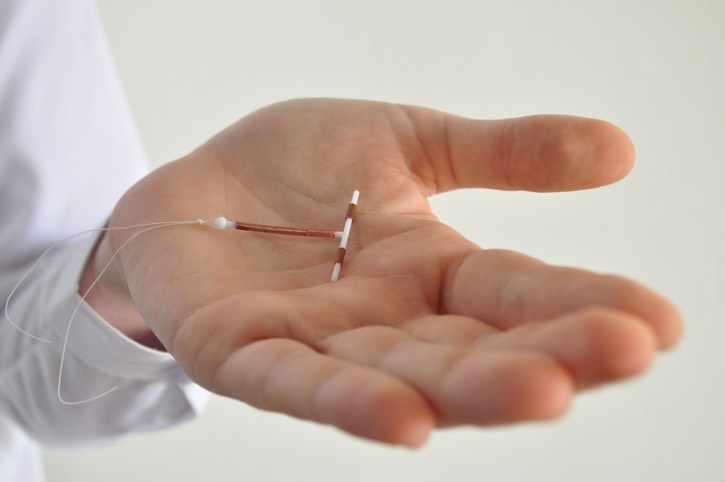When Will Linea Nigra Go Away? The Pregnancy Line on Your Stomach

Pregnancy brings a glow to many women, but it can also lead to a handful of less desirable dermatological conditions including a phenomenon called linea nigra or linea gravidarum. While this is an extremely common symptom of pregnancy, many new and expectant moms are eager to know if and when this dark line will disappear. Thus, we take a closer look at how to say goodbye to hyperpigmentation!
What is Linea Nigra?
Linea nigra is a dark vertical line that forms on a woman’s belly during pregnancy. Literally translated, the Latin term means ‘black line’. This marking normally extends from the pubic area to the rib cage along the center of the stomach and it stereotypically forms during the second trimester.
Interestingly enough, while a whopping 90% of women will experience the appearance of this pregnancy line, women with darker skin will notice a much more pronounced marking. This is due to the fact that there is more pigment present in their dermis compared to individuals with fair skin.
Additionally, what you may not realize is that this discoloration forms directly over a band of collagenous connective tissue — termed Linea Alba (‘white line’) — that stabilizes the abdominal muscles. This means that the marking has actually been there for your entire life. Prior to pregnancy, it was just too light to notice.
Why Does Hyperpigmentation Occur During Pregnancy?

As with many other common symptoms, the reason behind this change in skin color is due to the surge in hormones, specifically estrogen, progesterone, and MSH (Melanocyte-stimulating hormone), that pregnant women experience during early pregnancy. In case you didn’t know, MSH is created by the placenta and is responsible for the release of melanin, a natural skin pigment.
Unfortunately, these alterations in skin color are not localized to the stomach. A women’s areolas will also darken throughout her pregnancy to help her baby see where they need to latch during breastfeeding. Moreover, brown patches can appear on the cheeks, forehead, upper lip, chin, and nose. This condition is called melasma, otherwise known as the mask of pregnancy. While these changes are completely normal, many women find these blemishes to be undesirable and wonder when they will go away.
Thankfully, for most women, these lines and patches fade within a few months following delivery. However, this condition can come back during subsequent pregnancies, and for some, it may never fully go away.
Linea Nigra Gender Superstition
For the women who love to use pregnancy symptoms as a way to guess the sex of the baby, the positioning of this pregnancy line will supposedly tell you if you are expecting a boy or a girl. According to old wives’ tales, if the linea nigra line forms from your belly button to your pubic bone, you are having a girl. Conversely, if this dark line stretches from your belly button to your ribcage, you are having a boy!
Can Linea Nigra Occur When You Are Not Expecting?
Yes! Since this is a condition that is triggered by hormone fluctuations, non-pregnant women and even men can develop this type of localized hyperpigmentation. Typically, this cosmetic issue is seen with the use of hormonal birth control pills. However, it is also a symptom of both Polycystic Ovary Syndrome (PCOS) and Addison’s Disease. These conditions are known for causing an imbalance in hormones. Unfortunately, for these individuals, it is more likely that this blemish will be permanent.
It is also important to note that if you develop Linea Nigra and are not expecting or using hormonal contraception, it is imperative that you meet with your doctor to have your hormone levels tested and discuss the possibility of these conditions. If left untreated, Addison’s Disease can have life threatening complications and PCOS can lead to cancer.
Methods for Reducing the Appearance of Linea Nigra
Linea nigra normally appears during a woman’s 20th week of pregnancy. For those who are hoping to lessen their chances of a permanent skin change during their 40 weeks of gestation, we detail the best methods for success:
1. Wear Sunscreen
As we all know, sunscreen is designed to prevent changes in our skin’s coloring. This makes it a fantastic tool for preventing this line from becoming even darker due to sun exposure. For the best results, choose an SPF of at least 30. Then, apply your sunscreen 30 minutes prior to heading out in the sun and reapply as directed. Furthermore, if you are going to be outside for extended periods of time, consider sitting in the shade or covering up your pregnant belly.
2. Take Folic Acid

Taking a daily prenatal vitamin with at least 400 mcg of folic acid is not only crucial for a healthy pregnancy, it can also help with diminishing these types of dermatological conditions. Thus, take these supplements and incorporate foods that are rich in this vitamin into your diet. These can include dark leafy greens, citrus fruits, and legumes.
3. Choose a Non-Hormonal Birth Control Option

Since linea nigra is triggered by an influx in hormones, it should come as no surprise that you have to wait for your normal levels to return in order for this dark line to disappear. However, if you decide to get on hormonal birth control after delivery, this can keep these chemical substances above typical levels and prevent these discolorations from fading. Non-hormonal options include the copper IUD, barrier methods, condoms, vaginal gels, or spermicides. Talk to your OB-GYN to see if these options are right for you - never change up your method of birth control without speaking to your doctor first.
4. Consider Using Skin Lightening Products - But Be Careful
If you find that these skin conditions do not fade with time, you can also speak with a dermatologist about their recommendations on the best skin lightening products to help reduce the discoloration.
Bleaching creams are not safe for use during pregnancy or while breastfeeding so this treatment should only be used once you are done nursing. Moreover, in many cases, dermatology researchers have found that this type of treatment can have unsatisfactory outcomes. Therefore, always consult with a doctor to see if this method is ideal for your skin.
5. Give It Time & Be Patient!
Linea nigra is one of the many bodily changes that is considered a regular part of pregnancy. It is important to remember that patience is a virtue. It will take a few months for this line to fade, but that is assuming that your hormone levels will rebound quickly. For some women, it can take longer. A good rule of thumb is that if it took nine months to grow a baby, then it will take at least that amount of time for your body to get back to normal. If you do want to cover up this line while you wait for it to go away naturally, consider using makeup to hide the mark.
Pregnancy Skin Changes
When it comes to pregnancy, most women expect stretch marks and c-section scars, but skin discolorations can sometimes come as a surprise. Regrettably, no amount of hydration or moisturizing will prevent linea nigra. Weight loss will have no effect either. For most, time is the best remedy.
However, if you are a part of the small percentage of women who do not see these areas of hyperpigmentation disappear, try to remember that these changes are a badge of honor. Your body has just done an amazing thing! Be proud of the work that it has done and what it took to create your beautiful baby.

